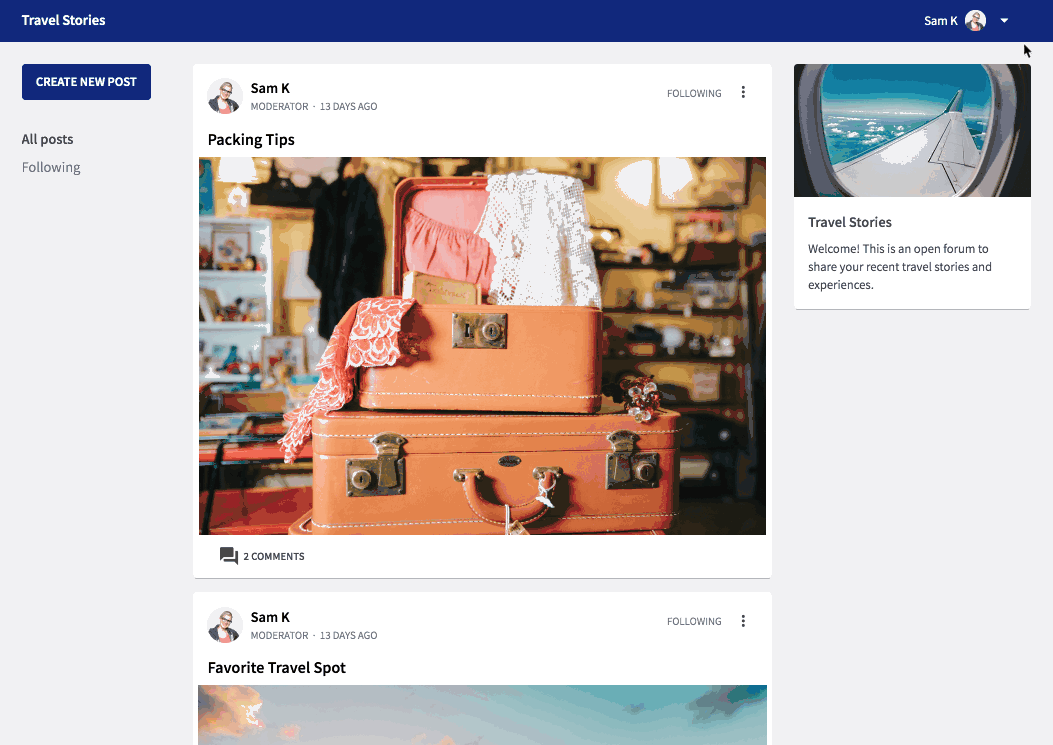Professional learning communities (PLCs) enhance instruction, drive a culture of collaboration, promote student learning, and drive innovation among professionals.
They allow educators to work closely with peers to develop new lesson plans, improve learning experience for their students, and design more impactful instruction.
But PLCs aren’t just for teachers. We’ll share how professionals across many industries, such as nursing, veterinarians, and entrepreneurial moms participate in professional learning communities. You’ll learn:
- What a PLC is
- How they apply to any profession
- Why people join them
- Different forms that PLCs can take
- How professional learning communities work
- Examples of professional learning communities that will inspire you
- How to create and sustain an effective learning community
- Platforms you can use to create a PLC
What is a professional learning community?
In education
A professional learning community is a group of teachers who work together at the same school, usually teaching the same grade, and come together to strategize on ways to improve student learning in specific areas.
PLCs have regular, ongoing discussions, gather inquiries centered around specific issues they want to explore related to student learning, collect data based on those inquiries, and later share findings with the group.
Some common inquiries include:
- What do we want students to learn?
- How will we know they’ve learned it?
Depending on the school, PLCs are generally formal, and their existence may be mandated by the school’s administration. PLC meetings occur regularly during the school year, usually during school hours and typically when students are at lunch or in exploratory classes, such as music, art, or physical education.
PLCs are important because they provide an opportunity for teachers to explore questions related to student learning, allowing them to share findings and ideas with one another and receive immediate feedback during back-and-forth discussions.
Outside of education
The same principles that drive social learning for teachers can be applied to just about any profession. While teachers and other education professionals were the first to coin the term professional learning community, these learning communities exist and thrive in other fields as well.
Learning communities can be organically formed and managed, or they can be created by an expert to add value to their online course or membership site.
Many online course creators didn’t start out with eLearning– they were pulled into online course creation by their community members.
Related: 7 Steps to Building An Online Community
Why do people join learning communities?
Learning communities are present in many industries and fields outside of education, and professionals and students choose to join them for many reasons, including:
- To develop new skills in their profession
- To support each other through academic programs, such as Latrina Walden’s study group for nurses
- To master a hobby, such as woodworking, scrapbooking, writing, or art
Types of learning communities
A learning community can generally be categorized into one of three primary types:
- Professional Learning Community (PLC): Typically composed of teachers who teach the same grade or subject, PLCs generally adopt a school-wide focus on improving student learning through a variety of methods that include discussion with other members of the PLC, data collection, and inquiry.
- Community of Practice (CoP): Communities of Practice can be found in education but are also common in government and business environments. CoPs refer to a group of people who share a common interest or set of problems and come together to meet individual and group goals. Members support and encourage each other as everyone works to meet the same objectives.
- Professional Learning Network (PLN): Broader in scope than the other learning community types, PLNs can include all the individuals one person is able to connect with online, which means members can live all around the world. In general, a PLN is a network of both people and resources that support ongoing learning. They’re also not exclusive to education and exist in a variety of industries and organizations.
So while there are a few specific types of learning communities, for the purposes of this article, we’ll focus on professional learning communities (PLCs) and explore their characteristics and core practices, as well as some tips on how to create and sustain an effective professional learning community.
Understanding how learning communities work
The effectiveness of professional learning communities is partially based on the fundamentals of social learning theory, a psychological concept that suggests new behaviors can be acquired by observing and imitating others — people learning from other people, for better or worse. And in the context of schools and educators, this is what professional learning communities offer — a chance for professionals to learn from one another.
Characteristics of learning communities
Learning communities, no matter what type they are, all share common characteristics around access, relationships, vision, and function.
For learning communities to succeed, they need:
- Proper levels of access: Learning communities must be able to meet in person or online on a regular basis. Both quality and quantity of time are important.
- Strong relationships: Members should have a strong sense of belonging to the group and trust in one another.
- Shared vision: Learning communities should share a similar vision in terms of outcomes and purpose.
- Organized structures in place: For example, in a PLC for teachers, the teachers in the group should work in the same grade or work with the same groups of students. And in a PLC in other industries, such as nursing or veterinary medicine, participants in the community should work in the same specialty and work on similar levels professionally.
Core practices in learning communities
According to research, in order for learning communities to be successful and effective, they must include these critical elements:
- Community
- Diversity
- Integration
- Active learning
- Reflection and assessment
Professional learning community examples that will inspire you
Learning communities don’t just exist in education — they can be formed in just about any industry, including medicine, business, and government. Here are a few examples of communities built by the course creators from Thinkific.
For veterinarians: The Veterinary Cytology Coffeehouse
Created by Kate Baker, DVM, MS, DACVP, the Veterinary Cytology Coffeehouse is a private, closed Facebook group for all types of veterinary professionals, including vets, students, vet nurses, and vet techs, who want to learn more about animal cytology and hematology.
Topics within the group are varied and range from interesting stories to common findings within the field and rare, out-of-the-ordinary examples.
In its first year, the group grew to 35,000 members without any advertising. Eventually, group members began asking for courses and opportunities to dive into some of these topics in depth. And that’s when Kate started creating courses on Thinkific that touch on many of these same veterinary topics.
For nurse practitioners: Help with exam prep
Latrina Walden, MHA, MSN, FNP-C, FNP-BC, of Latrina Walden Exam Solutions, who has also been a professor for over a decade in health care, created a Nurse Practitioner study group on Facebook to help young professionals enrolled in nurse practitioner programs pass their exams.
The group includes study guides, tips from other members, and live clinical reviews a few times a month. After receiving numerous requests for additional course materials during some of her live clinical Q&A sessions, Latrina began selling courses through Thinkific.
For entrepreneurial moms: Boss Mom
For mothers who want to raise their kids while still having a meaningful career, Boss Mom provides a wealth of resources and guidance to empower moms to achieve these goals simultaneously.
These are some of the reasons Dana Malstaff created Boss Mom, a business-building community for mom entrepreneurs.
For online course creators: Thinkific community
Thinkific’s community on Facebook is meant to serve as a discussion and resource-sharing platform for course creators. Members can share wins, discuss ideas and strategies and distribute information to help other course creators build successful businesses.
For teachers: Facebook teaching community
Several Facebook groups, including this Teacher’s Group, are formed so that teachers can get together and discuss new curriculum and lesson ideas, share strategies and how to implement them with individual students, and let others know about training and professional development opportunities.
For fitness and health instructors: JJ Virgin’s community
JJ Virgin, a Certified Nutrition Specialist, and Certified Health and Fitness Instructor, realized pretty early on in building her brand that she could achieve better results when she worked with people on their health and fitness goals within a group instead of individually.
“They get to interact with other people who are having challenges just like them and having successes just like them, and they get really tight in that group,” JJ explained recently in a workshop hosted by Thinkific.
One thing JJ tries to do in her programs to keep her community engaged, is breaking up content into manageable bite-sized chunks. This can be an effective strategy for learning communities because it allows participants to take in what they can when they can and not feel overwhelmed by receiving too much information at once.
Virgin sums up her community experience by saying: “The things that I’ve done in the consumer world, building a community, that doesn’t matter if it’s consumer or professional, we all need communities now more than ever. Connection is more important now more than ever. You wanna build brand loyalty, build a bad-ass community.”
How to create and sustain effective professional learning communities
Professional learning communities can’t thrive on their own; they need assistance from experienced people familiar with these types of groups. Here are some tips from Thinkific for creating and sustaining professional learning communities.
1. Understand your goals
Without a clearly defined purpose, professional learning communities can’t thrive. Learning communities are a means to achieve several end goals, and these may differ depending on the purpose behind the learning community and industry. In education, for instance, the goals of a learning community might be:
- Improving student retention
- Promoting student engagement
- Achieving consistency across instruction methods among teachers
- Promoting student learning
- Building a community among educators and other working professionals
2. Clearly position your community and align the goals of members
The purpose of the learning community should be clearly defined and goals outlined for each of its members. Consistency is key.
3. Provide structure and guidance: Group rules and a shared set of norms
In order for the learning community to achieve its outlined goals, structure and guidance are important to keep members on track and focused on objectives.
4. Create a culture of collaboration and empowerment
Everyone in the learning community should be encouraged to share their viewpoints and experiences so other members can relate to each other and share strategies.
5. Create a culture of growth
A PLC team should have a mindset of wanting to constantly improve and become more effective.
6. Make sure it’s reflective
Reflection is an important part of any learning process, and it’s especially vital for professionals in a learning community. To help foster this, a member of the team can select a component to be examined, whether it’s a practice or specific problem, and then set the stage for group reflection that’s successful.
7. Focus on results for members
Ensuring a learning community is learner-centered and focused on students or other people can help maximize ROI.
What’s the best platform to build an online learning community?
Facebook Groups
This is one option for building an online learning community. It allows leaders of the group to restrict membership, so it can be open or private, and the interface provides an easy-to-use place for group interaction and sharing useful information and resources.
One downside is that Facebook can also be distracting since it’s inherently a social network. Information can easily get lost in streams of notifications, and it’s less of a professional platform and more of a social platform.
LinkedIn Groups
Since LinkedIn is more business-oriented, it does provide a more professional platform for creating online learning communities among working professionals.
However, the main purpose of LinkedIn is to network and find employment, so it may be challenging to start an online learning community, although LinkedIn does offer a Groups feature.
Again, since LinkedIn is primarily more of a social and job networking site, it’s easy to get distracted by all the other page elements.
Thinkific
On Thinkific, it’s easy to create and sell online courses, memberships, and access to a private community – all under your own brand, and free from the distraction of social networks.
A Thinkific Community is a place, outside of your course content, where you can foster conversations with your students. Each Community has a dedicated page (on your Thinkific site) where students and instructors can interact through written posts and comments. Communities are similar to Facebook Groups, with access granted at either a site level, or associated with individual courses or bundles.

The benefits of creating a community on Thinkific
- Create your own branded Community: Just like everything you build with Thinkific, your brand is the star, with no outside distractions. Choose colors and key imagery, plus host your Communities on your own custom domain, without the noise and distractions of social platforms.
- Assign Community memberships: Assign Community access by a specific course, bundle or memberships, or create a site-wide Community to allow any of your students access!
- Fully integrated with your Thinkific site: Community members are automatically added (or removed) based on enrollments in your Thinkific content — no more manually adding and removing people.
- Built on a platform you can trust: Thinkific is trusted by over 50,000 course creators, and unlike social media platforms, you control all the content that appears in your Community. No ads, no tracking, no spam.
Related: Thinkific’s Support Article For Communities
Closing thoughts
Professional learning communities are vital to the success of educational programs. In PLCs, teachers learn from one another and ensure their students are learning important concepts.
Want to join a professional learning community created just for you? Join Thinkific’s community for course creators, or start creating your own community with our Pro plan today!








